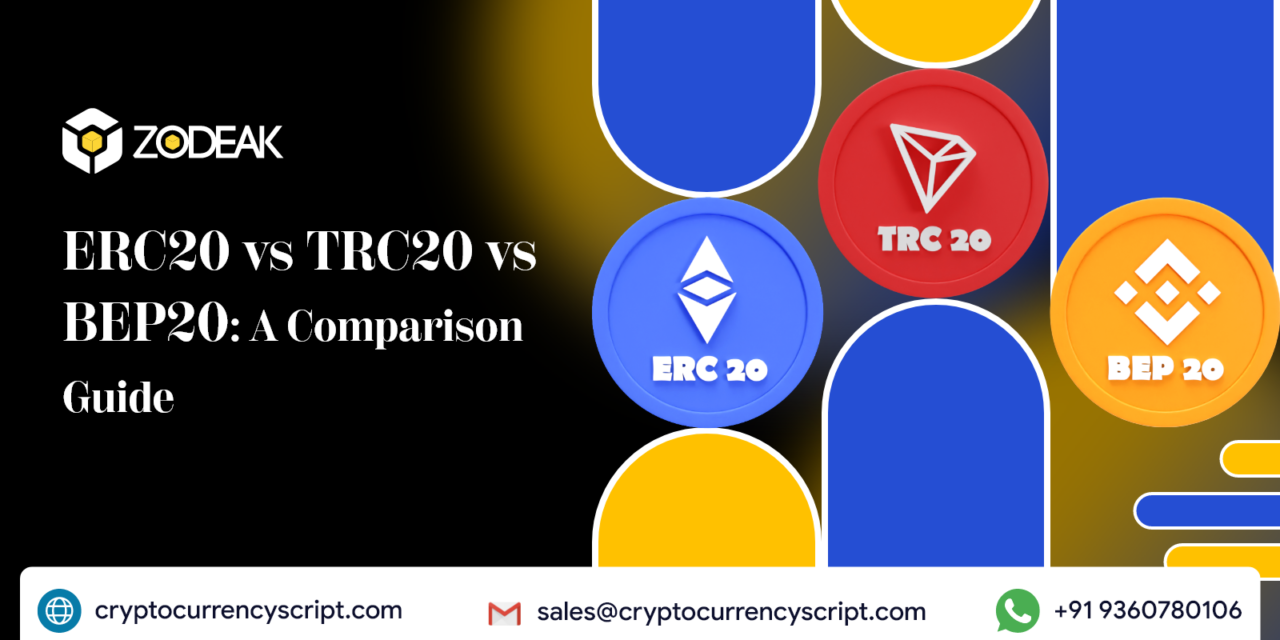If you are a crypto enthusiast and token launcher on ICO/IEO platforms, you already know the difference between token standards and ERC20 vs TRC20 vs BEP20. However, there are still a lot of people in the crypto industry who may not know the differences between these standards.
Are these standards fundamentally the same, or do they share commonalities? We will see the differences between these token standards to help you understand them better in this blog.
Exploring the Differences: ERC20 vs TRC20 vs BEP20
To start, let’s know these token standards and their respective blockchain networks:
ERC20 – Fungible token standard on Ethereum
ERC20 refers to the Ethereum request for concept 20, and this standard is responsible for the creation of fungible tokens on the Ethereum blockchain. They are widely used for various purposes including utility tokens in Ethereum, ICOs, and DeFi projects like Decentralized Autonomous Organisation (DAO).
TRC20 – Fungible token standard on Tron
TRC20 is the standard that governs the creation of the fungible token on Tron Blockchain. Like ERC20 tokens, TRC20 tokens can be use for ICOs and other applications in the Tron ecosystem. Tron offers higher transaction speed and scalability compared to Ethereum.
BEP20 – Fungible tokens standard on Binance Smart Chain
BEP20 resides on the Binance Smart Chain, which serves as the standard for the creation of fungible tokens. Binance Smart Chain has gained prominence due to its compatibility with Binance exchange and lower transaction fees, making it a desirable option for various projects.
These three blockchains have differences in how they work with different platforms and wallets, how fast they process transactions, how decentralized they are, and the fees they charge for transactions.
Blockchains and Their Standards Comparisons
Blockchain Compatibility
ERC20 tokens are exclusive to the Ethereum blockchain, while TRC20 tokens are specific to the Tron network, and BEP20 tokens are tailored for the Binance Smart Chain. This means that these tokens are not interchangeable between these networks without a conversion process.
Consensus Mechanism
Ethereum uses a Proof of Stake (PoS) consensus mechanism, with multiple moderators responsible for validating transactions and adding new blocks to the blockchain.
In contrast, Tron adopts Delegated Proof of Stake (DPoS), using 27 validators and Binance Smart Chain relies on a Proof of Stake Authority (PoSA) approach, involving 21 moderators that stake BNB, the native token of the Binance ecosystem, to secure the network.
Transaction Speed
Ethereum has faced challenges with transaction speed and scalability, which can result in slow transaction times of 15 sec and high gas fees. Conversely, both Tron and Binance Smart Chain offer faster transaction speeds of 3 sec, making them more efficient for operations such as exchanges and smart contract interactions.
Decentralization
Ethereum is often celebrated for its strong decentralization and offers high security. Tron and the Binance smart chain, while offering advantages in speed and efficiency, will not be as decentralized as Ethereum, raising questions about the level of regulation and governance.
Transaction Fees
Ethereum is known for its higher transaction fees due to network congestion. Tron and Binance Smart Chain offer lower transaction fees, which can be a significant factor for users and projects looking to minimize costs.
Comparison of Minting ERC20 vs TRC20 vs BEP20
When creating tokens on their blockchain, these standards have 6 code functions added to the smart contract code when generating ERC20, TRC20, and BEP20 tokens. They are totalsupply(), balanceOf(), transfer(), approve(), transferFrom(), and allowance().
Let’s take an overview of how these tokens are create on their blockchain.
Minting an ERC20 Tokens
Minting ERC20 tokens primarily involves developers familiar with implementing smart contracts. These self-executing contracts encompass predefined terms and conditions within their code.
The token creation process for ERC20 tokens consists of several steps, including defining token parameters, setting up a development environment, coding a smart contract, incorporating various functions, and testing and deploying the contract.
Minting TRC20 Tokens
For TRC20 tokens, creation is accessible to those skilled in the Solidity programming language. The TRC20 token standard is in line with the Ethereum ERC20 standard, making the smart contract design somewhat analogous.
To ensure seamless operations, TRC20 tokens must integrate six key functions, much like ERC20. Optional functions like token name, abbreviation, and precision can also be implement.
Minting BEP20 Tokens
BEP20 tokens, on the other hand, present a more simple minting process than others. The BEP20 smart contract involves six obligatory functions, along with additional parameters such as Mint, Burn, Blacklist, and Pause for customization. These parameters distinguish BEP20 tokens and provide flexibility in their usage.
Conclusion
In conclusion, understanding the differences between the ERC20, TRC20, and BEP20 standards is important. This leads to anyone considering getting into crowdfunding or building DAOs or Dapps. Whether you’re a startup founder or an established business, the demand for token development services continues to grow, and the potential for innovation is limitless.
Creating a successful crypto token is not just about writing smart contracts. It’s all about understanding the blockchain platform, target audience, and having a clear understanding of the purpose of your token. With insights you gain in this blog, you are better equipped to make good decisions to achieve your project’s objectives. Start today by approaching any BEP20 token Development Company to initiate your crypto project!





